For remote star photography, look for wireless triggers with BULB mode support, 50+ meter range, and long battery life. Budget-friendly options include the Pixel TW-283 ($30) and Vello FreeWave Plus (100m range). Keep spare batteries warm in freezing conditions and reduce LCD usage to extend battery life. Position your trigger within 100 feet of your camera and verify compatibility with your specific model. The right wireless trigger will transform your night sky captures.
Essential Features of Wireless Triggers for Astrophotography
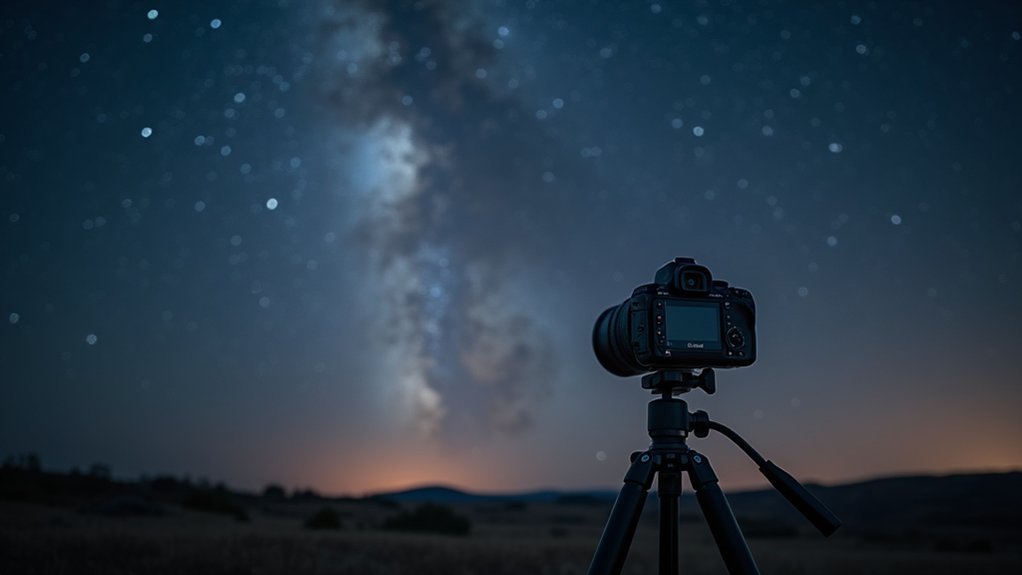
The perfect wireless trigger can make or break your astrophotography session. When selecting one, prioritize BULB mode support, which enables the long exposure times necessary for capturing celestial objects.
Look for triggers with at least 50-meter range, allowing you to step away from your setup to prevent camera shake that ruins star trails and planetary shots.
Ensure compatibility with your specific camera model—many quality triggers include interchangeable cables or customizable settings for cross-brand functionality.
Zero shutter delay is essential for immediate image capture without motion blur. Don’t overlook battery life; night sessions often stretch for hours, and you’ll need a trigger that won’t die midway through your shoot.
The right wireless remote control balances these features to help you capture the cosmos without unnecessary complications.
Top Budget-Friendly Remote Shutter Options for Star Photography
Quality star photography doesn’t require emptying your wallet on equipment.
You’ll find several affordable wireless shutter release options that effectively minimize camera shake during long exposures with your camera on a tripod.
The Pixel TW-283 stands out at $30, offering multiple shooting modes and broad compatibility.
Canon users might prefer the RC-6 at just $20, which works up to 16 feet away—perfect for star trails.
RC-6 delivers affordable precision for Canon shooters, ideal for capturing celestial movements from a comfortable distance.
Beginners should consider Neewer’s lightweight remote with simple one-button operation.
For greater range, try the Vello FreeWave Plus (up to 100 meters) or the Hama Wireless Remote DCCS, which extends to 150 meters with its universal connector.
Both provide excellent flexibility for capturing starry skies without disturbing your carefully composed shot.
Maximizing Battery Life in Cold Night Conditions
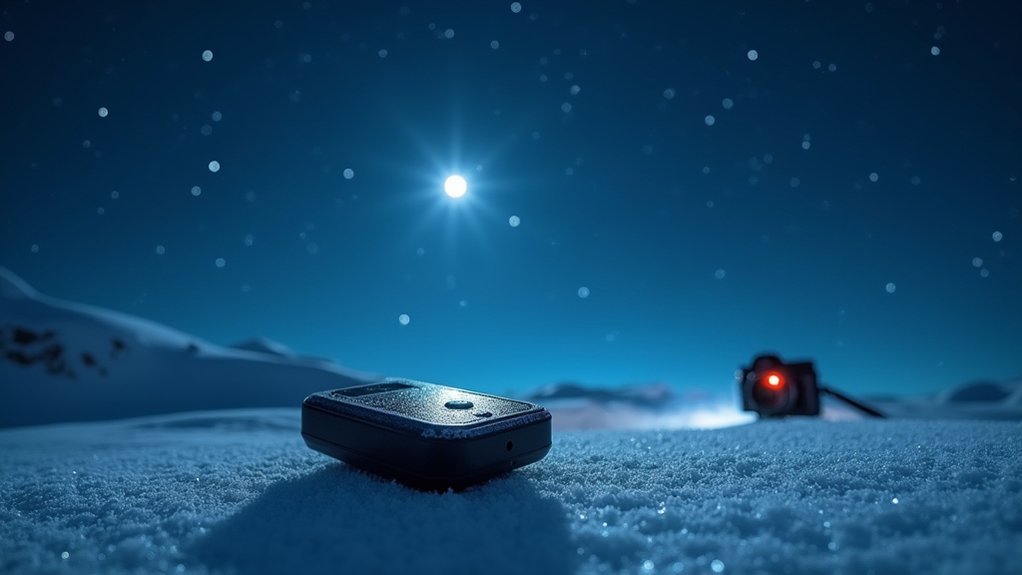
When temperatures plummet during nighttime star photography sessions, your camera’s battery life can diminish dramatically, threatening to cut your shooting short just as cosmic events unfold.
Lithium batteries can lose up to 50% capacity below freezing, severely limiting your remote trigger functionality.
Keep spare batteries warm in inside pockets or with hand warmers, and consider using insulated battery covers to retain heat.
For your wireless remote, opt for models with Bluetooth technology, which consumes less power than traditional alternatives.
Extend battery life by reducing LCD screen usage and limiting live view operations.
Set your camera for longer exposures to minimize how often you need to trigger the remote.
These simple adjustments will guarantee your battery life lasts through those critical moments when the night sky reveals its most spectacular displays.
Comparing Bluetooth vs. Radio Frequency Triggers for Celestial Imaging
When choosing between Bluetooth and RF triggers for your celestial photography, you’ll need to weigh their distinct operational ranges, with RF options offering considerably greater distance capabilities essential for wide-field astrophotography.
You’ll find RF triggers provide more reliable connections in remote shooting locations, making them preferable when interference might disrupt Bluetooth signals during critical night sky captures.
Your battery management strategy should account for the different power consumption profiles of each system, particularly since RF triggers typically offer longer operational life during extended star photography sessions in cold conditions.
Range Comparison Matrix
Although both technologies serve similar purposes, Bluetooth and radio frequency triggers differ considerably in their effective range capabilities for celestial photography.
When examining our range comparison matrix, you’ll notice that Bluetooth remote options typically max out around 50 feet (15 meters), limiting their effectiveness for distant setups often required in star photography.
RF triggers, by contrast, offer superior range capabilities—extending up to 100 meters (328 feet) in ideal conditions. This significant difference makes RF triggers the preferred remote release option for serious astrophotographers who need to position their cameras away from potential vibration sources.
Additionally, RF technology provides more reliable connections in environments with electronic interference, which is vital when capturing time-sensitive celestial events. Your choice should prioritize range and stability when shooting the night sky.
Signal Reliability Factors
Signal reliability stands as the cornerstone of successful celestial photography, extending beyond mere range considerations. When choosing a remote shutter release, you’ll need to evaluate how consistently it performs in challenging environments.
RF triggers outshine Bluetooth options when reliability matters most. With up to 16 channels, RF systems prevent interference between multiple camera setups—ideal if you’re capturing different celestial objects simultaneously.
You’ll appreciate that RF triggers don’t require line-of-sight operation, unlike some alternatives that falter in low-light conditions. Your Bluetooth trigger might struggle with interference from nearby devices and physical obstacles, compromising critical shots.
Additionally, RF triggers offer superior battery life for those extended night sessions under the stars, when every moment counts and changing batteries means missing fleeting astronomical events.
Battery Life Considerations
Two critical factors impact your remote trigger selection for celestial imaging: performance and power longevity.
When planning extended astrophotography sessions, battery life becomes paramount to your success.
Bluetooth triggers offer impressive efficiency, lasting up to six months with normal use and utilizing readily available, affordable CR2032 batteries. This makes them particularly valuable for lengthy star photography sessions without interruption.
In contrast, radio frequency triggers provide superior range (up to 100 meters) but consume more power during transmission, resulting in shorter battery life.
They do, however, demonstrate better reliability in cold temperatures where Bluetooth devices may falter.
For ideal results, always check and replace batteries in either trigger type before important celestial events.
Cold weather astrophotography enthusiasts might prefer radio frequency options despite their higher power consumption.
Setting Up Your Wireless Trigger for Long Exposure Star Trails
Your wireless trigger’s settings must be optimized for interval timing of 30 seconds between shots while maintaining the steady connection needed for perfect star trails.
You’ll want to preserve battery life by keeping the trigger in sleep mode between activations, particularly during frigid night conditions when batteries drain faster.
Position your trigger within 100 feet of your camera setup to prevent signal dropout, though many modern RF triggers can maintain reliable connections at distances of up to 300 feet in open-sky environments.
Selecting Optimal Trigger Settings
When capturing breathtaking star trails, properly configuring your wireless trigger settings becomes vital for successful long-exposure photography. Your shutter remote should be set to intervalometer mode, programming consistent 30-second intervals to track star movement effectively.
First, verify your wireless trigger’s battery is fully charged before beginning your session. This camera accessory can drain quickly during extended use.
Set your camera to BULB mode if your trigger supports it, then configure a higher ISO (1600-3200) and wide aperture (f/2.8 or wider) to gather sufficient light.
While wildlife photography often requires quick triggers, star photography demands patience and precision. Take test shots to verify your focus and composition before starting your sequence.
The benefit of your remote is making adjustments without touching the camera, eliminating unwanted vibrations during those vital long exposures.
Preventing Battery Drain Issues
Once you’ve optimized your trigger settings, battery management becomes the next challenge for successful star trail photography.
Choose a wireless remote trigger featuring Bluetooth 5.0 technology to minimize battery drain during those extended night sessions.
Set your device to BULB mode to maintain continuous shutter operation without repeatedly pressing buttons, which conserves significant power.
Always opt for high-capacity batteries or quality rechargeable options that provide reliable performance throughout your shooting session.
Before heading out, thoroughly check your trigger’s battery level and pack spares to avoid interruptions during critical moments.
Position both your camera and wireless remote trigger securely to prevent unnecessary adjustments that might accidentally activate the device and waste precious battery life.
These simple precautions will guarantee uninterrupted star trail captures even during the longest exposures.
Distancing Without Signal Loss
Maintaining reliable connectivity between your camera and remote trigger represents one of the most critical challenges in star trail photography.
To maximize your shooting distance without signal loss, select a wireless trigger with sufficient range—models like the Vello FreeWave Plus operate reliably up to 100 meters, perfect for long exposure setups where you need to stay warm in your vehicle.
Position your receiver with clear line of sight to your camera, especially when using infrared remotes that require direct visibility.
For tethered shutter release alternatives, guarantee your wireless trigger supports BULB mode for complete control over extended exposures.
Check compatibility with your camera model, as some may require specific adapters to function properly.
Finally, verify your remote’s battery life can handle overnight sessions—the Pixel TW-283 offers months of use, preventing frustrating mid-shoot failures.
Troubleshooting Connection Issues During Night Sky Sessions
Despite meticulous planning, connection problems between your camera and remote trigger can quickly derail an otherwise perfect night of astrophotography. When your remote suddenly stops responding, first check battery levels—even partial power drain can cause intermittent connection failures.
Verify your devices are properly paired by double-checking Bluetooth settings or frequency channels. For peak performance, stay within your trigger’s operational range (typically 50-100 meters) and maintain a clear line of sight, especially with infrared models.
Persistent interference issues can often be resolved by switching to a less congested frequency band.
Don’t overlook firmware updates for your camera system, as manufacturers regularly improve compatibility with wireless triggers. These simple troubleshooting steps will keep you focused on capturing the stars rather than fighting technical frustrations.
Frequently Asked Questions
Why Do Astrophotographers Prefer Remote Shutter Release Rather or Release Timer in Astrophotography?
You’ll prefer remote shutter releases as they completely eliminate camera shake, unlike timers which still require touching the camera. They’re also more convenient during long exposures in cold nighttime conditions.
What Is the Vello Freewave Plus Wireless Remote Shutter Release?
The Vello FreeWave Plus is a wireless remote that lets you trigger your Canon or Nikon camera from up to 100 meters away. You’ll enjoy multiple shooting modes and its portable design.
What Is a Wireless Remote Shutter?
A wireless remote shutter is a device you’ll use to trigger your camera without touching it. It eliminates vibrations, works from a distance, and helps you capture shake-free long exposures or self-portraits.
Why Could a Remote or Cable Shutter Release Reduce Camera Shake?
A remote or cable shutter release reduces camera shake because you’re not physically touching the camera when triggering the shutter. This eliminates vibrations from your hands that would otherwise blur images during long exposures.
In Summary
You’ll find that investing in a quality wireless trigger transforms your astrophotography experience. Whether you choose Bluetooth for convenience or RF for range, select a trigger with reliable connectivity and strong battery performance in cold conditions. Don’t forget to test your setup before heading out, and always carry backup batteries. With the right remote trigger, you’ll capture stunning star trails and celestial images without camera shake ruining your shots.
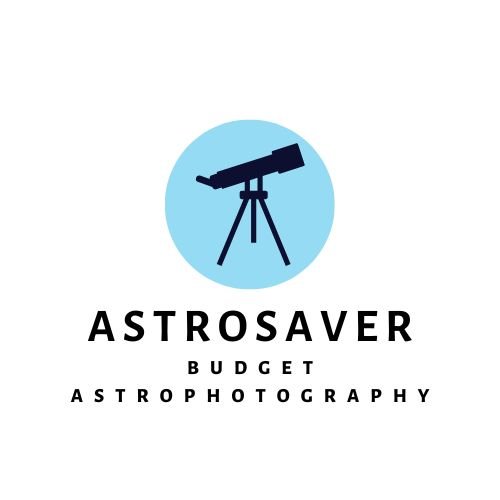

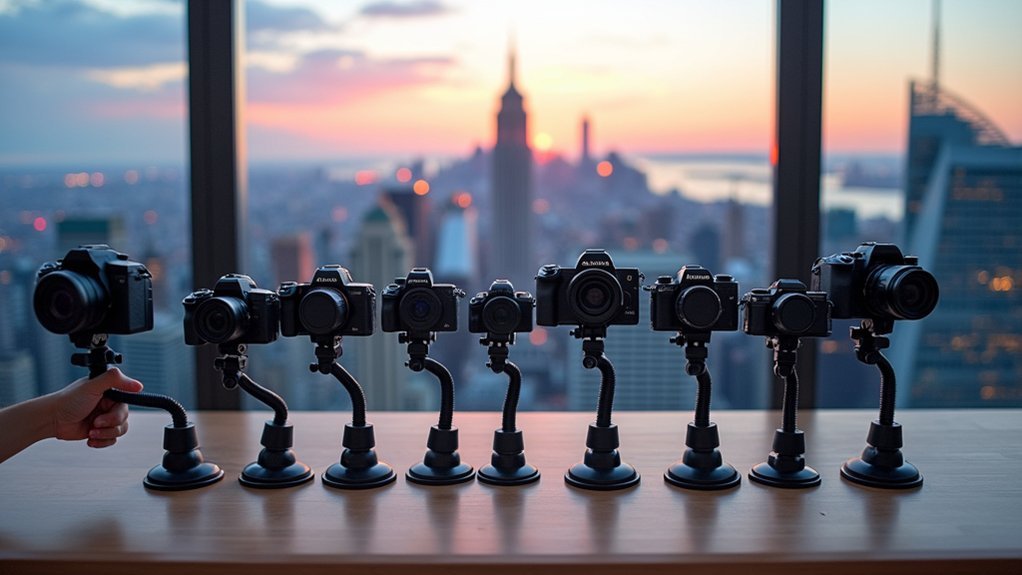

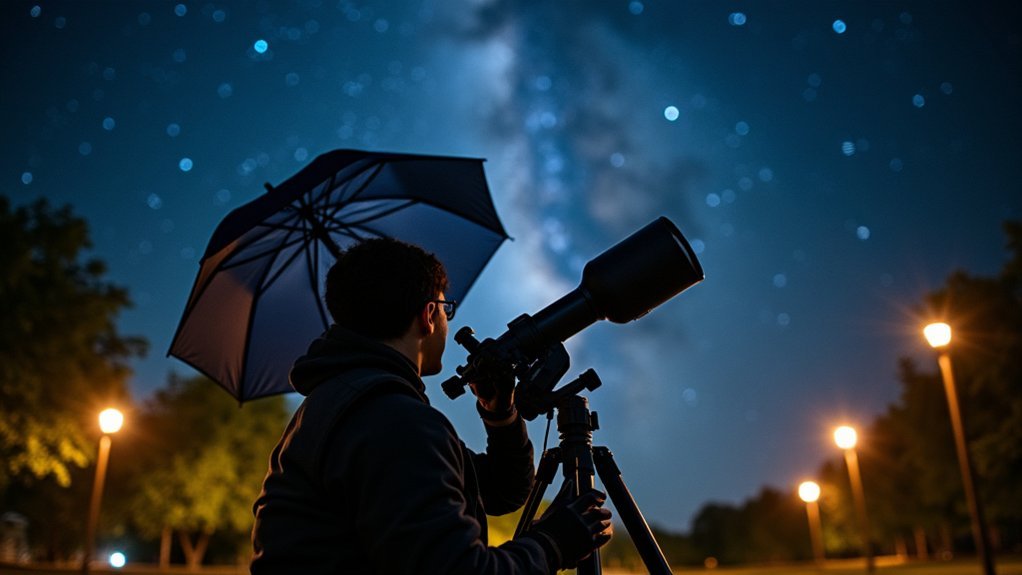
Leave a Reply